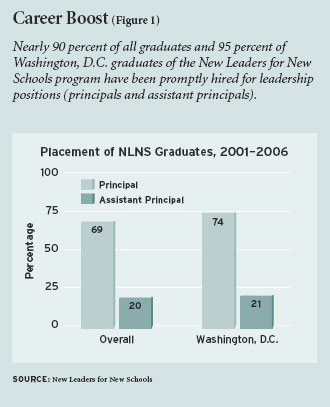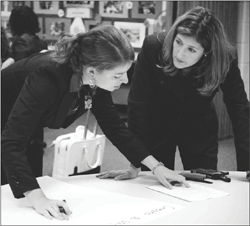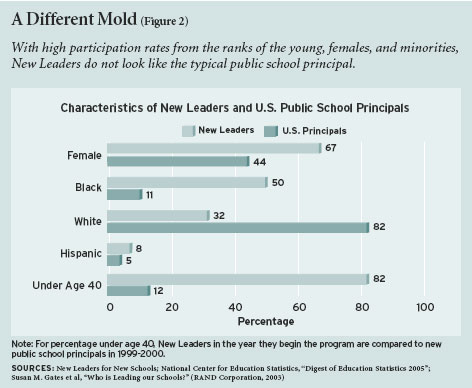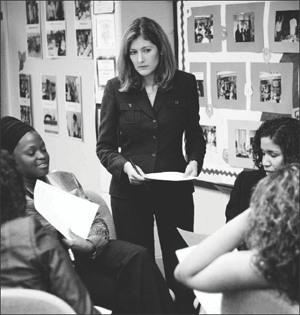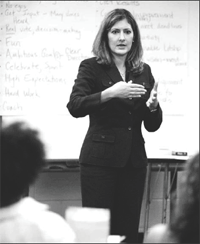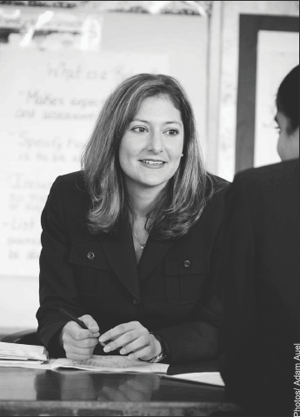 In recent years Frank W. Ballou Senior High School in Washington, D.C., has suffered some well-publicized traumas, including the on-campus murder of a 17-year-old and a deliberate mercury contamination by students that forced the school to close for a month. Meanwhile, barely 3 percent of students scored “proficient” in reading, and just under 10 percent did so in math. In comparison, the firing of Ballou’s principal in the summer of 2005–the second sacking in as many years–seemed like a mercifully dull event.
In recent years Frank W. Ballou Senior High School in Washington, D.C., has suffered some well-publicized traumas, including the on-campus murder of a 17-year-old and a deliberate mercury contamination by students that forced the school to close for a month. Meanwhile, barely 3 percent of students scored “proficient” in reading, and just under 10 percent did so in math. In comparison, the firing of Ballou’s principal in the summer of 2005–the second sacking in as many years–seemed like a mercifully dull event.
For Jacquelyn Davis, any mention of Ballou brings back sharp memories. “Ballou is where I had my awakening,” says Davis. In 1999, as a second-year law student at Georgetown University, she taught a legal course at the high school. “My students at Ballou were incredibly smart but their skills were on such a low level,” she says. “Some of them were close to being illiterate.” She realized that the school was broken but felt powerless to fix it. “It was painful to witness,” she says.
Today Davis, 35, wields considerable influence over Ballou and, in fact, almost every public school in Washington, D.C. As the executive director of the Washington office of New Leaders for New Schools (NLNS), Davis is overseeing a rapidly expanding crop of new principals who are promising to revitalize a long-ailing system. The nonprofit NLNS has agreements to train principals in five other U.S. cities–Chicago, New York, Baltimore, Memphis, and the Oakland Bay area. With only about 80,500 students in public and charter schools, Washington has one of the smallest student populations of the NLNS program cities, and program graduates make up a sizable share–almost 20 percent after just three years–of the city’s principals. NLNS alumni are principals or assistant principals in 45 of Washington’s 200 public schools (see Figure 1). Within a few years, half of all D.C. schools could be in the hands of NLNS alumni.
Someone Who Can Do It All
Davis grew up in Port Arthur, Texas, where her father served as a school board member during the massive effort to desegregate that city’s schools, and she was among the first white students to attend a formerly segregated elementary school. “In some ways I’ve always been thinking about these issues of race and class and education,” she says. As an undergraduate at Brown University, she studied school reform with Ted Sizer, and not long after moving to Washington in 1993 to work for a congressman, she co-founded Hands on DC, a nonprofit that uses volunteers to make repairs in the city’s notoriously dilapidated school buildings and provide college scholarships to low-income students.
None of this, she says, prepared her for the dysfunction she discovered while teaching at Ballou, which was jarring enough to sideline her career as a lawyer. Instead, she headed for public education. She and some Georgetown classmates, also Ballou veterans, launched Thurgood Marshall Academy, a law-related high school just blocks away from Ballou and one of the city’s first charter high schools.
Davis became an administrator at Thurgood Marshall. She recruited the school’s first principal and learned firsthand what it takes to lead an effective school. That work led to an insight that would reverberate. “You can have amazing teachers,” Davis says. “But if you don’t have a principal holding it all together … the school’s not going to work.” The principal she helped hire was highly qualified, she recalls. “But even he wasn’t perfect.” She saw close-up the staggering array of skills requisite in a successful principal, from managing a multimillion-dollar budget, to being an instructional leader, to working with parents and community members. “How do you find someone who can wear all these hats?” Davis asks.
Great Schools Have Great Principals
In 2002 Davis met up with an old friend, Jonathan Schnur. They’d first met while working on Bill Clinton’s 1992 presidential campaign. Both passionate about education as a fundamental right for every child, their shared interests had kept them in contact. “For years the two of us had been having discussions about education and about how to make schools work for all kids,” says Davis. “We were always both focused on the students who were too often left behind in urban schools–low-income kids, kids of color.”
Schnur, as a Clinton administration education-policy adviser, had spent lots of time visiting schools across the country. “And one pretty simple but powerful insight became clear,” he says. “Great schools have great principals.” He used the premise to write a two-page concept paper describing a program for recruiting, training, and supporting new urban-school principals. He says he was eager to launch the program right away. “You’ve got no program, no funding, no team,” Schnur recalls one friend cautioning him. “You’ve never been a principal. You need to develop this more before you launch.”
So Schnur took his idea and enrolled in the Harvard Graduate School of Education in 1999 where he joined forces with some students from the Harvard Business School. Together they refined Schnur’s concept and entered it in Harvard’s annual business-plan contest. New Leaders for New Schools, as Schnur dubbed the program, was the first nonprofit to be named a semifinalist in the competition. This helped secure start-up funding, including $1.15 million in grants from the NewSchools Venture Fund, a California-based venture philanthropy firm.
By late 2002, NLNS was up and running in New York, Chicago, and the Oakland Bay area, with three cities submitting bids to be the next expansion site. Schnur, now CEO of the nonprofit, selected Washington and asked Davis to launch the new program office. The hiring of principals, says Schnur, is entwined with community politics. Davis, just over 30, was already intimate with the politics and players of the D.C. education landscape. Schnur states her qualifications more bluntly: “We needed someone who could bring people together and get things done.”
Finding the Best Woman (or Man) for the Job
Jacquelyn Davis’s desk is awash in papers. It’s an early December morning, 2005, and applications for next year’s “cohort” of New Leaders are rolling in. Last year, 260 people applied to the program, and 18 were accepted. Selection involves several rounds of written responses, interviews, case studies, and problem-solving exercises, where applicants are judged on 10 criteria, from “belief in the potential of all children to excel academically” to “project management” to “self-awareness.”
“I personally interviewed around 150 people last year,” says Davis. “At an hour and a half per interview, that’s where I spend a lot of my time.” The final round involves an eight-hour simulation of a day in the life of a principal. Irate parents? Teacher observations? A ruptured boiler? NLNS didn’t want to reveal specifically what problems are thrown at applicants during the simulation, except to say that anything a principal might encounter is fair game.
NLNS recruits all have teaching expertise, but are drawn from a range of sectors–private industry, education, nonprofits, law, the military–and are put through a yearlong boot camp, which includes weekly classes and a hands-on, medical residency-style apprenticeship with a mentor principal. The training is followed by two years of on-the-job support. New Leaders in D.C., Davis says, have on average six years in the classroom and adult leadership experience. Average age is 35. Two-thirds of the New Leaders are women (see Figure 2).
NLNS doesn’t push a particular curricular model or reform package. Rather, says Schnur, the yearlong training program emphasizes three core principles: All children can excel academically and behaviorally; principals are instructional leaders; classroom decisions should be driven by data. “We think that these principles are incredibly important,” says Schnur. “Research shows that these are the kinds of things that happen in highly effective schools, and if you don’t do them you’re not likely to have an effective school.”
Central Office Shuffle
Last December Davis was facing another urgent task: hammering out a formal agreement with the D.C. Public Schools (DCPS). For the previous several years, NLNS had been operating essentially with no contract from D.C. Public Schools. The only written commitment she had from the school system was a four-line letter from then new superintendent, Clifford B. Janey, dated March 2005, saying that D.C. Public Schools will “cover the Residency year salaries … for up to 20 New Leaders who will train in DCPS during the 2005-2006 school year.”
Contrast that with the 22-page Memorandum of Understanding (MOU) that then D.C. superintendent Paul Vance inked with NLNS in 2003. This document defined the nitty-gritty, who-does-what of the partnership. NLNS pledged, for example, “to identify classroom spaces for the courses” that the New Leaders would take during their yearlong training, while the school system promised to “identify outstanding practitioners from the D.C. Public Schools who could serve as faculty or guest lecturers in these courses.”
Vance and his chief of staff, Steven Seleznow, were among the driving forces in bringing NLNS to Washington. “It was pretty clear that we needed them,” says Seleznow. “One of the levers of change is to have really strong leaders in the schools, and we didn’t have the in-house capacity to recruit and train the best principals. With New Leaders we saw an opportunity to build an almost immediate capacity.” He acknowledges that there was concern that graduates of the program, with relatively little experience, would not be up to the task of running schools. “But we did our due diligence, and given the quality of the training, the quality of the people New Leaders had been able to recruit in other cities, the mentors they would have, we felt we were minimizing the risk” of their inexperience. Besides, says Seleznow, a former principal in Montgomery County, Maryland, “There’s no experience that can totally prepare you for your first principalship.”
For the most part, the 2003 Memorandum of Understanding mirrored agreements that NLNS had with other school systems. At the core lay a financial arrangement, with D.C. Public Schools paying the New Leaders’ salaries during training and NLNS covering the program costs, leaving Davis to raise a $1.5 million annual operating budget.
But in at least one regard the D.C. agreement broke new ground. Superintendent Vance agreed to grant NLNS graduates who excelled during their residency year–and were subsequently hired as principals–increased decision-making authority and autonomy. The New Leaders were promised greater control over budgets, staffing, curriculum, and professional development.
“New Leaders felt strongly that their principals had to have autonomy,” says Seleznow. “They wanted to immunize their principals from a lot of the problems that came along with being a captive to the bureaucracy.” He says there were plans eventually to offer the autonomy to all qualifying principals because their union worried about the New Leaders becoming a “favored group of principals with tools that other principals did not have.”
At the time, it appeared that NLNS, having just arrived in Washington, was destined to be a lot more than a supplier of principals. It was helping to shape policy, placing principalship at the center of the reform agenda.
“I tell you all of this for naught,” says Davis, after describing the autonomies in the 2003 MOU. Seleznow retired a few weeks after helping to work out the agreement. And soon Vance did, too.
“To be very candid with you, I just don’t want to be bothered with it all,” Vance told reporters, describing his frustrations with running D.C. Public Schools.
With the loss of these key partners, says Davis, NLNS had to gain new champions in the central office, and the program had to find new supporters. The promises in the MOU quickly fell into limbo, and it was clear that the autonomies for NLNS principals would not take root. “We had a ‘gentlemen’s agreement’ about how these autonomies would be worked out, but the specifics were not in writing. I didn’t anticipate such a quick transition in the top-level leadership,” Davis recalls. “People who remain constant in the system are often not the most senior staff people, and it’s through relationships with those people that we get a lot done. They are the foundation of the system.”
Despite the setback, Davis did not veer from the plan to recruit and train a cohort of would-be principals. She became a constant presence in the central office building, reminding workers there who she was and what NLNS was trying to do. “I know everyone’s secretary really well,” Davis says. “And that matters because every single assistant superintendent position has turned over at least once, and some of them have turned over three times since I’ve been here. And the secretaries have remained. So when I call and say to the secretary, ‘I’m calling from New Leaders,’ the secretary says ‘Of course. How are you?’ and my call gets returned” by the assistant superintendent.
Breaking Through
Getting a phone call returned is one thing. Getting a New Leader hired is another. D.C. Public Schools was never obligated to hire any of the New Leaders. “Our people have to compete in the hiring process just like other candidates,” says Davis. In other cities, early graduates of the program had difficulty being hired as principals and were often brought on as assistant principals or other administrators. (See “The Waiting Game,” features, Summer 2004). Many of the New Leaders were perceived as outsiders.
Yet Bernard Lucas, president of the Council of School Officers, the union representing D.C. principals and assistant principals, worries that New Leaders are leapfrogging over other job applicants. “The concern is that people who have worked very diligently, who have had excellent evaluations over the years, who have the skills, that they are being pushed to the side and overlooked when positions become available,” says Lucas. He adds that he supports the NLNS concept. “If the people who come out of the New Leaders program go through the selection and interview process on top, then so be it. But just because these other individuals did not go through the program does not mean they don’t have the vision or are incapable of leading the schools.”
Davis says that in some ways being an NLNS graduate can be an obstacle, for the simple fact that New Leaders don’t look like other D.C. principals. “If they have it in their minds that the principal should be a man who’s sixty … this is a very different thing than selecting an instructional leader who’s 35, who’s female, who might have dreadlocks. Changing what a community thinks a principal is and what a principal should do has been a lot of work.”
For Davis, breaking through has meant leading workshops for job-seeking New Leaders. “We tell them, know the school that you’re going to interview for. Know the data, know the community, know the players. We had one New Leader who went out and walked the neighborhood before her interview. And then in the interview she talked about the people she’d met in the neighborhood. That was a kind of liftoff moment for her.”
So far the strategy has worked. Of the 47 New Leaders Davis has shepherded through the hiring gauntlet, only one, Melissa Kim, was not immediately hired by a D.C. public school. She spent a year as an assistant principal in nearby Arlington County. “I think part of it is that she seemed young,” says Davis about Kim, who was 28 years old when she graduated from NLNS. In the summer of 2005 Kim was hired to run Deal Junior High School in D.C.
Back to Ballou
It’s too early to say whether or not the New Leaders are making a significant impact on student achievement, although RAND has been enlisted to study the program. Schnur says the results are due in 2008.
One milestone brings Davis particular delight. In July 2005, D.C. Superintendent Clifford B. Janey appointed Karen Smith, a recent NLNS graduate, to be the new principal of Ballou. Smith brought in two NLNS graduates to serve as assistant principals–creating a team of like-minded educators working together to turn the school around.
Last year, even before the firing at Ballou, Davis says that she began discussions with the school system about which New Leaders “could take on challenging high schools.” In particular, she touted Smith, then a 33-year-old former high-school English teacher and program director for Teach For America. Smith had spent her training year as an assistant principal at McKinley Technology High School in Washington, where she helped craft the budget, manage the facility, and deal with parents.
When the Ballou job opened up, Davis encouraged Smith to consider it. “I didn’t know if I was ready for that,” says Smith. “But I felt up for the challenge.”
Superintendent Janey evidently agreed. He directly appointed Smith to the Ballou principalship, skirting the normal process involving community panels. “I was ecstatic,” recalls Davis, who says that Ballou, under Smith’s direction, is on the path to reform.
“I was told by a lot of people that I needed to be a man. I was told that Ballou’s principal needed to be a man,” Smith says. She recalls her response to the critics: “I can’t deny that I’m younger than most principals. I can’t deny that I don’t have as much experience, but here’s what I’m going to do.”
In September 2006, on the first day of school at Frank W. Ballou Senior High School, Davis returned to the school that had so profoundly affected her years earlier. In the year since Smith assumed the principalship, reading scores had improved. The halls were calm; students were in their classrooms. One student told her, “Ms. Smith does not play, but she loves us and we know it.”
“The building is already significantly different than the one I knew,” says Davis. “There’s more structure, more order. The culture has shifted enough now for Smith to focus on instruction and student learning–the stuff that matters most.” She couldn’t help but feel a sense of satisfaction: “On a personal level I’ve had my eye on that school for a long time.”
Tyler Currie is a contributing writer for the Washington Post Magazine.


